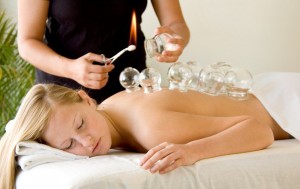Cupping therapy is an ancient Chinese healing tradition, dating back to 1000 BC and potentially even earlier than that. Many years later… cupping garnered attention thanks to celebrities and professional athletes—including Gwyneth Paltrow, Jennifer Aniston and Olympic swimmer Wang Qun—showing off their post-cupping bruises in public. Yet, despite the buzz, cupping remains a mystery to mainstream healthcare. In America, the practice is often found in the worlds of physical therapy, alternative wellness and athletic trainers.
So what is cupping therapy?
Cupping therapy essentially uses suction on the skin to enhance blood circulation in the body, clear blockages, help relieve muscle pain, remove toxins from the body and ultimately to promote healing. Think of cupping therapy as the inverse of a massage: instead of a masseuse using their hands to apply pressure on the patient’s muscles, the practitioner creates a vacuum in a cup made of bamboo or glass and then immediately places the cup on the skin. The suction pulls a section of skin and blood away from the body and into the cup. After a short amount of time—which varies depending on the patient—the cups are removed and the practitioner then massages the skin, redistributing the blood throughout the body.
The two primary methods within the therapy are dry cupping and wet cupping. The only difference between the two is that in wet cupping, a small incision is made in the skin so that the suction draws out a small amount of blood, while dry cupping involves no incisions. Wet cupping, or Al-Hijama,is commonly practiced in Islamic societies, as it was endorsed by the Muslim prophet Muhammad in early Islamic texts. They are meant to serve the same ultimate healing goals.
To create the vacuum in the cup, most practitioners use the heat from a flame, although some use a suction pump instead. The former method is called fire cupping in which the practitioner lights an alcohol-soaked cotton ball on fire and uses it to quickly heat the cup before placing it on the skin. Though it may not sound safe, the cup is not hot enough to burn the skin (although if you have especially sensitive skin you may want to avoid it).
While cupping is often performed on a patient’s back, it can be performed anywhere on the body; some receive the therapy on their chest in order to relieve congestion or help with respiratory issues.
It is understandable for modern Americans who are accustomed to mainstream medicine to be skeptical about cupping therapy. From an outside perspective, the practice seems painful and even dangerous. Especially after the fact, when the patient is left with big circular bruises. But as long as you work with a certified professional, the practice is meant to be painless and harmless.
There is little scientific evidence to prove or explain the effectiveness of this practice, but the therapy has received widespread praise from those who practice it regularly. The therapy is offered at many holistic wellness centers but has not penetrated the medical mainstream in any meaningful way.
This practice is not for everyone, but for chronic pain patients exploring complementary therapies for their pain management, cupping therapy is certainly worth a try.
Resources
- http://www.mindbodygreen.com/0-16791/3-reasons-everyone-should-try-cupping.html
- http://acupuncturetoday.com/abc/cupping.php
- http://www.pacificcollege.edu/news/blog/2014/09/20/many-benefits-chinese-cupping
Take the First Step Towards Pain-Free Living Today


